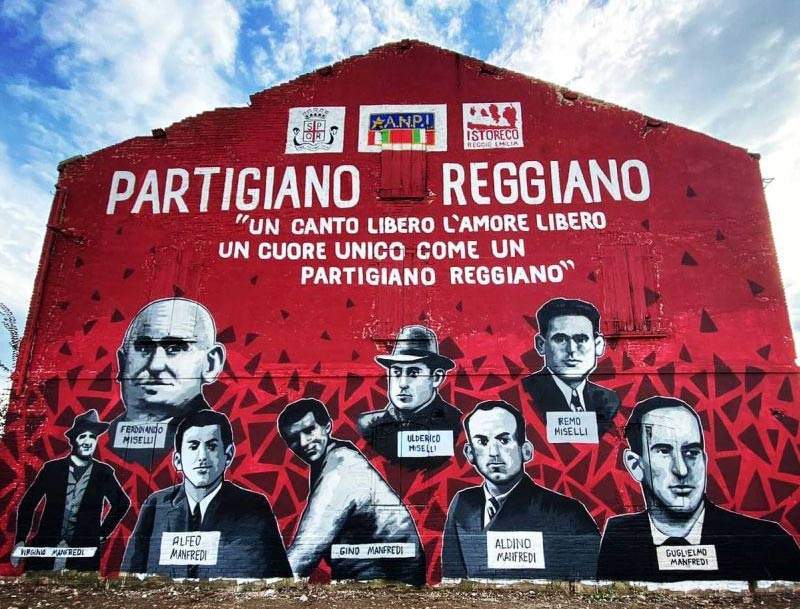A request by Autostrade per l’Italia to have the Partisan Reggiano mural decorating the facade of Casa Manfredi, in Villa Sesso, just outside Reggio Emilia, becomes a case: according to autostrade, the mural, which is located along the A1 highway heading toward Bologna, distracts motorists. The mural was unveiled on September 27, 2020: it bears the signature of two street artists, Fabio Valentini (Neko) and Marco Temperilli (Maik), and was commissioned by the Institute for theHistory of Resistance and Contemporary Society (Istoreco) of Reggio Emilia.
The work depicts the five members of the Manfredi family killed by fascists in 1944: father Virginio and sons Alfeo, Gino, Aldino and Guglielmo. Next to them appear the effigies of three other slain anti-fascists, namely Ferdinando Miselli and his sons Remo and Ulderico. The images are accompanied by the inscription “A free song, free love, a single heart like a partisan from Reggio Emilia,” a line from the song Partigiano Reggiano by Zucchero Fornaciari. The farmhouse that houses the work is the very one that was once inhabited by the Manfredi family.
Autostrade has sent Istoreco a notice to remove it, but it has not reckoned with the media uproar raised by its request. Many people have expressed disappointment with Autostrade’s request. “We will not delete the ’Partisan Reggiano’ mural,” said Reggio Emilia Mayor Luca Vecchi. “Casa Manfredi is a symbol of the Resistance. We are in contact with Autostrade, we will find a solution together. The mural is an integral part of our DNA. It commemorates a very serious event, a Nazi-fascist roundup. That place is a living monument that has stood in Villa Sesso for decades. The painting enhances the history and example of the Manfredi brothers, the sacrifice of the Miselli family, the unspeakable suffering endured by so many families and a historic hamlet of our town, and was created on the facade of their birthplace. It does not contain any commercial communication, it is not a sign, placard, poster or advertising plant.”
The president of the Emilia Romagna region, Stefano Bonaccini, also intervened to defend the mural. “The mural must not be erased,” he affirmed. The Reggio Emilia area, Bonaccini explains, “paid a very high price to the Nazi-Fascist madness, in terms of massacres, mourning, violence. Woe betide those who gave their lives to give us back freedom, peace and democracy.” According to Cristian Sesena, secretary general of the Reggio Emilia CGIL, “Autostrade should take care of the maintenance of bridges and viaducts, restrooms and rest areas, remembering that it manages a public good of citizens, instead of thinking about removing or covering a mural. Such a claim immediately lends itself to negative readings: are the history of an area, its memory, distracting and therefore should be removed, leaving the void in their place? These are questions we ask ourselves again and again, for example, when cyclically, close to April 25, someone wants to rehabilitate succumbing fascism in order to downplay the significance of partisan liberation struggles, or dedicate this anniversary to covid victims as happened this year. As CGIL we believe that the mural should remain exactly where it is to be seen, by people passing through, because Reggio Emilia is in that history and that history is not erased, covered up or moved elsewhere.” According to Sesena, the mural “does not distract motorists, at most it educates them; considering history and memory as a distraction is an ugly vice of these mala tempora.” And then came Zucchero’s stance as well: “I hope the matter is resolved in the best way possible,” he wrote on his Facebook page, “and that is that the mural at Villa Sesso in Reggio Emilia remains in place. This we owe to the memory of the Martyrs of the Resistance. And, as I say in my song, we must be for a free world, a free dream, a free song ... ”.
After noting the reactions, Autostrade made a statement outlining its solution (basically, not to cancel the work but ... plant trees in front of it). “The Bologna Section Management of Autostrade per l’Italia,” it wrote in a note, “highlights the widest availability and willingness to cooperate to ensure the remembrance of the partisan victims, in compliance with the legal parameters necessary to guarantee the safety of users in transit on that stretch of highway. The Trunk Management has already organized an initial meeting with the contact persons of the local institutions and will make contact with the associations involved to evaluate together (and with the endorsement of the technical offices of the Ministry of Infrastructure and Sustainable Mobility) all possible hypotheses, including the planting of tall trees that would preserve the work, while mitigating the significant visual impact of motorists. Alternatively, alternative walls, found for example in areas adjacent to the cottage, could be identified where the same mural could be reproduced, obviously with the full financial support of the Trunk Management. The Bologna Trunk Management assures all its commitment to put in place, in a shared way with the institutions and associations of the area, the best solution.” In Reggio Emilia, however, the prevailing position is that the mural should not be touched.
 |
| Highways against Partisan Reggiano mural: distracts motorists |
Warning: the translation into English of the original Italian article was created using automatic tools. We undertake to review all articles, but we do not guarantee the total absence of inaccuracies in the translation due to the program. You can find the original by clicking on the ITA button. If you find any mistake,please contact us.